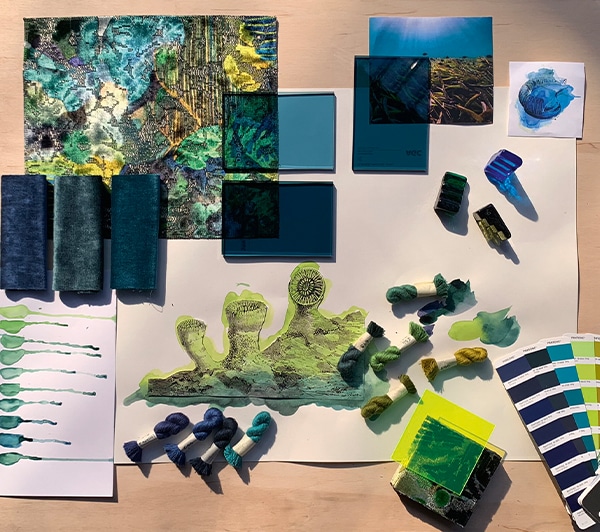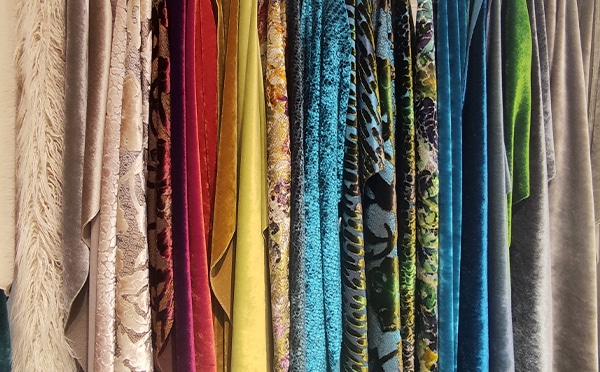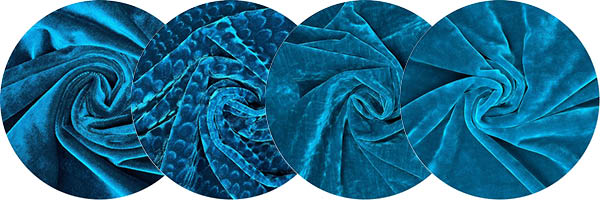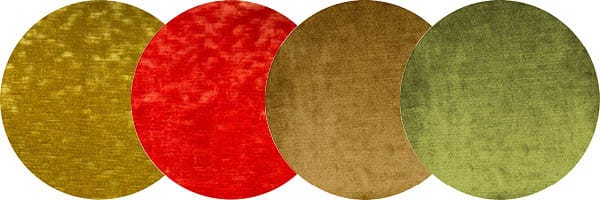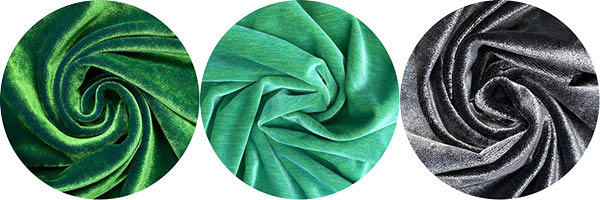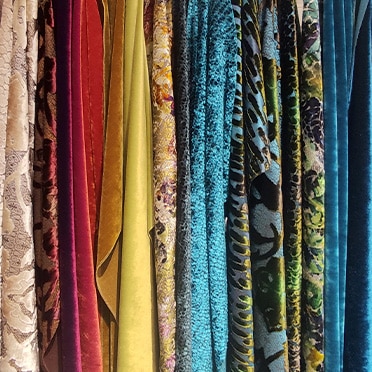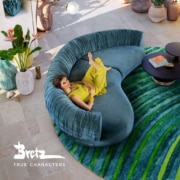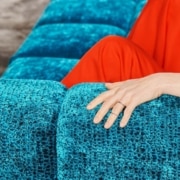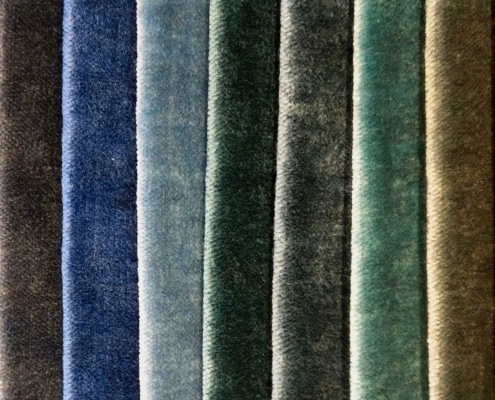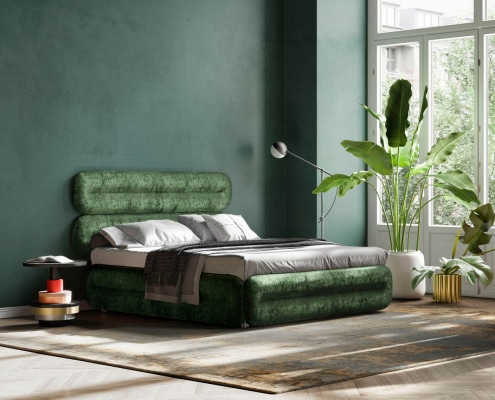VELOUR MON AMOUR – A FORAY THROUGH VELVETY
Bretz has always been known for its unique, noble upholstery fabrics: the Bretz-Velours. But what makes our velours so special? What is the difference between the various fabric groups, what is a jaquard fabric, what is a mohair? To understand our velours and get an insight into our collection, we invite you on a foray through the wonderful world of velour fabrics..
IN THE SELECTION OF OUR VELOURS WE WORK TOGETHER WITH RENOWNED MANUFACTURERS FROM ITALY, GERMANY AND BELGIUM
First, we work with moodboards: We combine structures, colours and patterns, we find interesting an magic. We develop unique concepts, which are then further developed with the manufacturers until our velour is finally created. The result of this collaboration: unique, individual, exclusive fabrics developed especially for us. This enables us to present our customers with an up-to-date collection of over 170 unique velours every year.
BUT WHAT ACTUALLY IS A VELOUR?
Velour is a general term for velvets and velvet-like fabrics with a short, erected fibre cover made of cut pile loops. Velours comes from the French and means velvet in German, but should not be confused with it. But what does velvet mean and how does it differ from velour?
The decisive factor is the length of the pile: this is shortest in velvet and causes the fabric to look different depending on the direction of the stroke. Velour refers to a textile fabric whose appearance and properties vary depending on the manufacturing process. This means that velour can have a roughened, soft, velvety or plush surface.
This surface is created during weaving: the loops of thread remain loose. The loops can then be cut open, creating a pile of threads protruding at right angles from the fabric. The longer the pile, the fluffier the velour.
AND WHICH VELOURS SUITS ME?
First of all, it can be said that long pile velours are softer than short pile velours,
velours made of synthetic fibres are more resistant and more lightfast than those made of natural fibres. Long pile velour, as the name suggests, has a very long pile height, which makes it particularly soft and cosy.
Long pile velour is generally known as plush. Short pile velour or velvet is characterised by its short pile height. A short pile velour is somewhat less soft than a long pile velour, but it is also
very durable and long-lasting. It is less prone to pressure marks.
WE OFFER THE RIGHT VELOURS FOR EVERY LIFESTYLE AND TASTE..
THE VARIOUS FABRIC GROUPS (61, 63, 64, 65, 66, 67, 68, 70) SUBDIVIDE THE BRETZ VELOURS ACCORDING TO PRICE.
The classification is by no means an indicator of quality, but only reflects the composition (synthetic fibres are always cheaper than natural fibres), grammages and finishes, such as special weaves, digital prints or stain protection.
THE JAQUARD VELOUR – FINE TWINE
Jaquard is a weaving method that was developed in 1805 to weave patterns in velour for the first time. Velour de Gene is a velour with high and low zones. The base fabric is visible as a patterned flat weave, the motifs are surrounded by velour. These velours can then be digitally printed. All in all, a very elaborate process. Arabesk, Boa, Seabreeze, Gobelin, Mikado und Paradise ar all Velours de gènes.
A Jaquard loom in action
POLYESTER VELOURS – THE ALL-ROUNDER
Polyester is a synthetic fibre and is particularly robust and easy to care for. Since dirt can’t penetrate the synthetic fibre, it can almost always be removed. In addition, velours made of polyester are significantly cheaper than those made of natural fibres. The fabrics from the 61, 63, 65 fabric group as well as the 64 Happy Velvet, for example, are pure polyester velours and are suitable for all those who want a robust and durable sofa cover, for example if pets or small children live in the household.
THE PURE VISCOSE VELOUR – THE DIVA AMONG VELOURS
Viscose is a type of natural fibre which is obtained from plant fibres, for example bamboo, and chemically processed into a semi-synthetic yarn in a viscose process.
Fabrics made of viscose have a silky sheen and a velvety feel. They are also breathable. This means it feels pleasantly cool on the skin. However, viscose absorbs moisture and reacts to body pressure with changes in the pile. These changes in the pile layer are also known as “use luster”. An anti-stain finish helps to reduce this effect.
The “Vintage Velvet” fabrics and the group of 65 BOH fabrics are pure viscose velours and should rather be used in the back (cushion) as well as in the carcass area, as strong seat reflections can occur especially in seating areas – a typical sign for a genuine viscose velour. The sofa gets a natural patina – A velour for real velours lovers only…
VISCOSE BLENDED FABRIC – SENSUAL, TACTILE, WONDERFUL
Fabrics made from a viscose blend are often a great alternative to the pure viscose velours. By blending other yarns, the viscose yarn is “supported” and therefore much less prone to pressure marks. Fabrics made of viscose-blended fabrics are for example the fabrics of fabric categories 66 and 67.
MOHAIR-VELOURS, THE CRÈME DE LA CRÈME
is a high-quality, pure natural product and is considered to be very durable and long-lasting. It is the wool fibre of the mohair goat. Wool has a natural anti-stain finish, as the fibre itself does not absorb dirt. The fabric group 70 – as the name suggests, made of 100% mohair.
VELVET HERE, VELVET THERE, VELVET EVERYWHERE
You can get detailed advice on the right model and the right velour in any of our flagship or partner stores.
If you are already a proud Bretz velours lover and owner, you will find care and cleaning tips in our Bretz care brochure.

